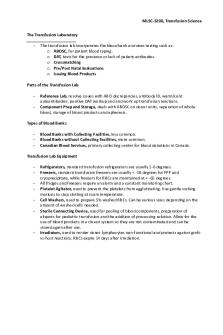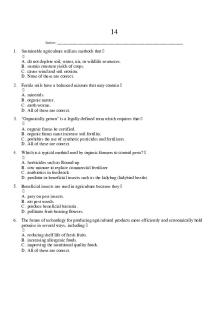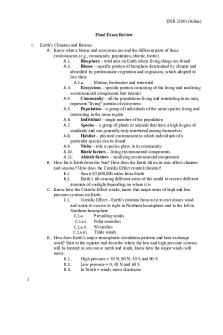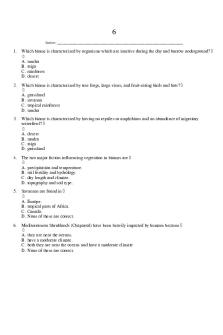Intro to Transfusion Science PDF

| Title | Intro to Transfusion Science |
|---|---|
| Author | Joshua Rupert |
| Course | Transfusion Science |
| Institution | University of Ontario Institute of Technology |
| Pages | 3 |
| File Size | 78.2 KB |
| File Type | |
| Total Downloads | 92 |
| Total Views | 951 |
Summary
MLSC-3200, Transfusion ScienceThe Transfusion Laboratory- The transfusion lab incorporates the blood bank and does testing such as: o ABOSC, for patient blood typing. o DAT, tests for the presence or lack of patient antibodies. o Crossmatching o Pre/Post Natal Evaluations o Issuing Blood ProductsPar...
Description
MLSC-3200, Transfusion Science The Transfusion Laboratory -
The transfusion lab incorporates the blood bank and does testing such as: o ABOSC, for patient blood typing. o DAT, tests for the presence or lack of patient antibodies. o Crossmatching o Pre/Post Natal Evaluations o Issuing Blood Products
Parts of the Transfusion Lab -
Reference Lab, resolve issues with ABO discrepancies, antibody ID, warm/cold autoantibodies, positive DAT workup and and work up transfusion reactions. Component Prep and Storage, deals with ABOSC on donor units, separation of whole blood, storage of blood products and apheresis.
Types of Blood Banks -
Blood Banks with Collecting Facilities, less common. Blood Banks without Collecting Facilities, more common. Canadian Blood Services, primary collecting center for blood donations in Canada.
Transfusion Lab Equipment -
-
Refrigerators, standard transfusion refrigerators are usually 1-6 degrees. Freezers, standard transfusion freezers are usually < -18 degrees for FPP and cryoprecipitate, while freezers for RBCs are maintained at < -65 degrees. All fridges and freezers require an alarm and a constant monitoring chart. Platelet Agitator, used to prevent the platelets from agglutinating. Use gentle rocking motions to stop clotting at room temperature. Cell Washers, used to prepare 5% washed RBCs. Can be various sizes depending on the amount of washed cells needed. Sterile Connecting Device, used for pooling of blood components, preparation of aliquots for pediatric transfusion and the addition of processing solution. Allow for the use of blood products in a closed system so they are not contaminated and can be stored again after use. Irradiators, used to render donor lymphocytes non-functional and protects against graftvs-host reactions. RBCs expire 14 days after irradiation.
MLSC-3200, Transfusion Science Quality Management in Transfusion Science -
-
Quality Control, operational techniques used to fulfill the requirements for quality. Reveals when method, equipment or procedure are not working as expected. Examples include standards and quality control materials for machine references. Quality Assurance, planned systematic activities that are implemented into the system to provide us with confidence that the requirements for quality will be fulfilled. Decreases error and ensures result credibility and confidence. Examples include accurately labelling and testing blood components, accurate transfusion services and safe blood transfusion. Quality System, procedures and resources that are needed to implement quality management. Provides a framework for applying QC and QA. Compliance Vs Quality Assurance, compliance measures the application of standards at a single point. It doesn’t address any structural underlying problems that are present. A quality assurance program is needed for that as it goes above and beyond to ensure quality results.
Quality Management System Essentials -
-
-
-
Organization, uses a quality management team and an organizational chart showing the relationships between the different authoritative levels. Customer Focus, ensures that the need of the customer (patients) is put first. We offer patient care as our product, and it should be delivered with quality all the time. Facilities and Safety, must be followed very closely. Enforced through things like safety training, PPE use, WHIMIS/SDS and emergency preparedness. Personnel, quality begins and ends with personnel. Personnel must have the training, experience, education, and orientation necessary for the job. Purchasing Inventory, the process of selecting product and vendors that provide the best quality. Involves the process of maintaining a proper inventory of products and monitoring expiration of products. Equipment, involves having up to date equipment that is accredited and calibrated. Equipment must also be documented for service, maintenance, and malfunction. Documents and Records, documents are approved information written electronically or physically. Records are captured results that are captured on forms in permanent ink. Entries must be legible and signed for responsibility of the results. Process Control, a way of showing that the personnel are being efficient in solving problems with results and processes. Occurrence/Incident Management, capturing of incidents and accidents that have negative impacts on personnel or the lab. Aims to improve quality and not to punish individuals. Continual Quality Improvement, quality management is a dynamic process and does not stay static. Requires audits and evaluations to ensure that everyone is working towards quality improvement. Includes making plans, policies and taking action towards quality.
MLSC-3200, Transfusion Science -
LEAN, a process of identifying non-value-added activates that are considered wasteful for elimination....
Similar Free PDFs

Intro to Transfusion Science
- 3 Pages

BIO LAB Intro to Science
- 12 Pages

HW4 -5206 intro to data science
- 3 Pages

Lab 1 Intro to Science- eScience Lab
- 13 Pages

Blood Transfusion
- 2 Pages

Intro to textiles
- 8 Pages

Intro to Med Term
- 41 Pages
Popular Institutions
- Tinajero National High School - Annex
- Politeknik Caltex Riau
- Yokohama City University
- SGT University
- University of Al-Qadisiyah
- Divine Word College of Vigan
- Techniek College Rotterdam
- Universidade de Santiago
- Universiti Teknologi MARA Cawangan Johor Kampus Pasir Gudang
- Poltekkes Kemenkes Yogyakarta
- Baguio City National High School
- Colegio san marcos
- preparatoria uno
- Centro de Bachillerato Tecnológico Industrial y de Servicios No. 107
- Dalian Maritime University
- Quang Trung Secondary School
- Colegio Tecnológico en Informática
- Corporación Regional de Educación Superior
- Grupo CEDVA
- Dar Al Uloom University
- Centro de Estudios Preuniversitarios de la Universidad Nacional de Ingeniería
- 上智大学
- Aakash International School, Nuna Majara
- San Felipe Neri Catholic School
- Kang Chiao International School - New Taipei City
- Misamis Occidental National High School
- Institución Educativa Escuela Normal Juan Ladrilleros
- Kolehiyo ng Pantukan
- Batanes State College
- Instituto Continental
- Sekolah Menengah Kejuruan Kesehatan Kaltara (Tarakan)
- Colegio de La Inmaculada Concepcion - Cebu








